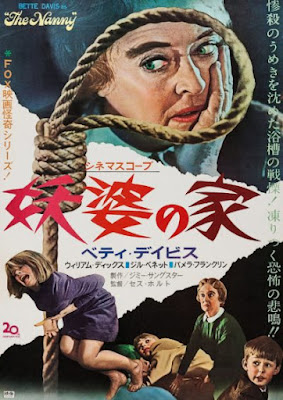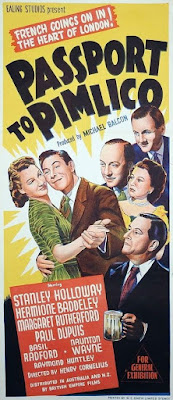Even with five non-horror projects in-between, Bette Davis knew she had a tricky career needle to thread after reestablishing her brand with the one-two Grand Guignol punch of WHAT EVER HAPPENED TO BABY JANE/’62 and HUSH . . . HUSH, SWEET CHARLOTTE/’64. Here, she choose wisely, if not too well, signing on for slow-boil domestic suspense from top Hammer Film writer/producer Jimmy Sangster. With an insufferable rise-above-your-station British middle-class accent (and very good at it!), Davis plays indispensable nanny to a broken family: little girl drowned, young son held responsible, parents, child & nanny uncomfortably reunited after a two year separation meant to tame the boy’s guilt-driven acting out; he’s still a terror. And while the boy may be incorrigible (excellent debut by William Dix who soon left acting), that’s not to say he’s wrong about what actually happened. In other words: It’s the nanny, stupid. No wonder he refuses to eat anything Nanny cooks up for him; let her in the bathroom while in the tub; even take discipline from his exhausted/exasperated parents. Better to climb up the fire escape to the neighbors’ flat where doctor’s daughter Pamela Franklin offers a more sympathetic ear. Not that she entirely believes him. Leaving Davis to play the martyr as her charge makes wild charges against her. Whom are you going to trust? An impossible wild child or a middle-aged nanny arching a pair of alarmingly thick eyebrows?* The film works, but there’s something unnecessary about it.
DOUBLE-BILL: NANNY did well enough for Sangster & Davis to return with THE ANNIVERSARY/’68, a non-horror play adaptation (not seen here).
SCREWY THOUGHT OF THE DAY: *‘My Nanny, what thick eyebrows you have!’ What's with those scary things? Yikes! An inside reference? Perhaps the Pre-Glam Charlotte Vale who Davis played in NOW, VOYAGER/’42. Or a wicked take on the ill-advised makeup strategies of aging former co-star Joan Crawford.































